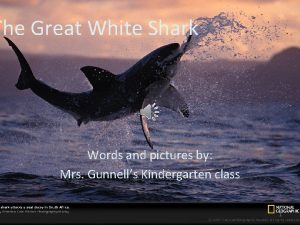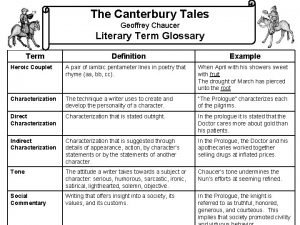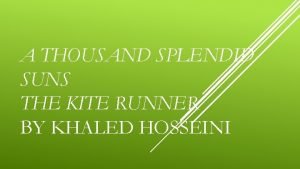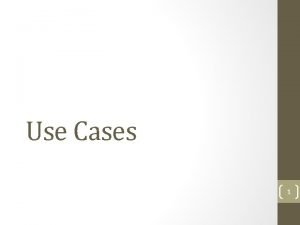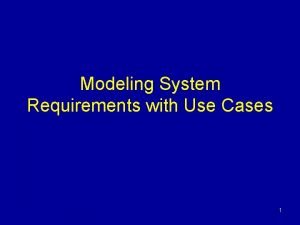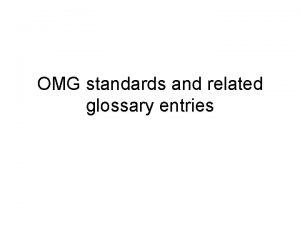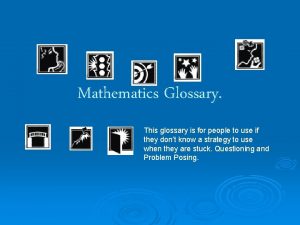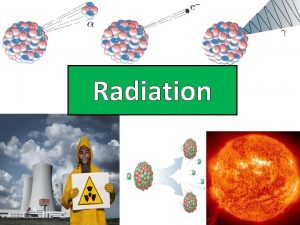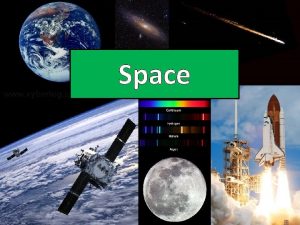Waves Waves Glossary Slide 3 Waves and Energy


















- Slides: 18

Waves

Waves Glossary Slide 3: Waves and Energy Slide 10: Diffraction Slide 4 -5: Frequency Slide 11: EM Spectrum and Wavelength Slide 6: Wavelength and Amplitude Slide 12: EM Spectrum, Wavelength and Frequency Slide 7: Transverse Waves Slide 8: Longitudinal Waves Slide 9: The Wave Equation Slide 13: Frequency and Energy Slide 14 -15: Reflection Slide 16 -18: Refraction

Waves and Energy Transverse Wave All waves transfer energy. The three wave types we consider in Physics are water waves, sound waves and electromagnetic (EM) waves. The two types of motion for waves are transverse and longitudinal. Longitudinal Wave Notice how the particles vibrate, transferring energy along the way.

Frequency is the number of waves that pass a point every second. The easiest way to remember it is f = N/t =, where f is the frequency, N is the number of waves and t is the time (in seconds). This equation does not appear on the equation sheet so you must memorise it. The red dot will be that we Consider the waves in point the animation measure below. the waves passing. The time your mouse the We next can count howclick many waves pass a 10 seconds begin. then Count how many point in 10 will seconds determine the waves pass using the red frequency f =dot N/t. in that time. Time (s) 10 9 8 7 6 5 4 3 2 1 0 The number of waves that pass is about 2. So the frequency is, f = N/t f = 2/10 f = 0. 2 Hz 0. 2 waves pass per second.

Frequency Now let’s see how the frequency of our transverse wave animation compares. Again, count the number of waves passing the red dot in 10 seconds. Time (s) 10 9 8 7 6 5 4 3 2 1 0 This time the number of waves that pass is about 10. f = N/t f = 10/10 f = 1 Hz 1 wave passes per second. For these 2 examples, the transverse wave had the higher frequency (5 x higher).

Wavelength and Amplitude The wavelength is the length of one complete wave cycle. One wave cycle could be from peak to peak or trough to trough. The amplitude is from the middle of the wave to the peak or from the middle of the wave to the trough (same size).

Transverse Waves For transverse waves, the particles vibrate at right angles to the direction that the wave is travelling. Vibrating Particles Travelling Wave

Longitudinal Waves For longitudinal waves, the particles vibrate in the same direction that the wave is travelling. Vibrating Particles Travelling Wave

The Wave Equation Imagine yourself speed walking. The two factors which will affect your speed are how many steps you take each second and the length of each step. This means the frequency of your steps and your step-length dictate your speed. It is the exact same for waves – the frequency of the waves and the wavelength dictate the speed of the waves. speed = number of waves per second multiplied by the length of each wave speed = frequency x wavelength v = fλ ms-1 Hz m

Diffraction Small Wavelength = Less Diffraction (less bend) Diffraction is when a wave bends around an obstacle. The smaller the wavelength the less it diffracts; the larger the wavelength the more it diffracts. The following diagrams shows different radio waves trying to reach a house so it can get a TV signal. Large Wavelength = More Diffraction (more bend)

EM Spectrum and Wavelength The electromagnetic spectrum shows all kinds of electromagnetic waves. The spectrum shows electromagnetic waves with the longest wavelengths on one side through to the shortest wavelengths at the other side. All EM waves travel at 3 x 108 ms-1 in the air and in space.

EM Spectrum, Wavelength and Frequency As all EM waves travel at 3 x 108 ms-1 in air and v = fλ then as wavelength decreases the frequency must increase. Therefore, the EM radiation with the longest wavelength has the lowest frequency (radio) and the EM radiation with the shortest wavelength has the highest frequency (gamma). Look at the spectrum and this can be seen.

Frequency and Energy The higher the frequency that an electromagnetic radiation has the more energy it has. Which EM radiation has the most energy? Gamma radiation Which EM radiation has the second lowest energy? Microwave radiation

Reflection When light bounces off of a surface we call this reflection. When a surface is not smooth the light reflects in random directions. When the surface is smooth (like a mirror) then we can determine how the light will reflect off. In Physics, we only consider reflection off of smooth surfaces.

Reflection Below is a diagram of what it would look like if we carried out an experiment using a ray box and a mirror ray of reflection ray of incidence angle of reflection normal (dotted line, 90 o to the surface) The Law of Reflection is, the angle of incidence = the angle of reflection

Refraction A vacuum is a term for describing a region which has no particles in it, it is completely empty. A medium is the opposite of a vacuum. It has particles and can be a solid, liquid or gas. The plural for medium is media. So if you just had glass you would have one medium. If you had glass and irn-bru you would have two media.

Refraction When light passes from the air into another medium (like glass or water) then its speed decreases. When light passes from a medium (like glass) into the air then its speed increases. This difference in speed can cause the light to bend at the surface of different media. We call this refraction.

Refraction Below is two diagrams for refraction. One shows light passing from air into glass. The other shows light passing from glass into air. angle of refraction ray of incidence normal angle of incidence If the light is decreasing in speed it bends towards the normal. If the light is increasing in speed it bends away from the normal.
 Heel and toe polka steps
Heel and toe polka steps Cscmp meaning
Cscmp meaning Glossary of usage worksheet answers
Glossary of usage worksheet answers Pictures
Pictures Kingdomality personal preference profile
Kingdomality personal preference profile A thousand splendid suns the kite runner
A thousand splendid suns the kite runner What is revpor
What is revpor Pabalat na pahina
Pabalat na pahina Expertir
Expertir Map with boltss
Map with boltss Social studies grade 8 textbook our worldviews
Social studies grade 8 textbook our worldviews Managed futures glossary
Managed futures glossary Difference between private equity and venture capital
Difference between private equity and venture capital International glossary of hydrology
International glossary of hydrology Ap spanish lit reading list
Ap spanish lit reading list Use case glossary
Use case glossary Who health promotion glossary
Who health promotion glossary Where does photosynthesis happen
Where does photosynthesis happen Use case narrative
Use case narrative



